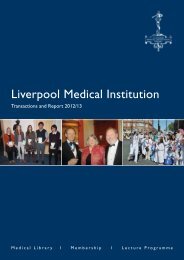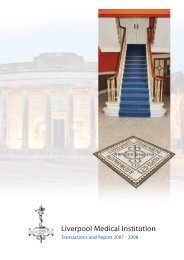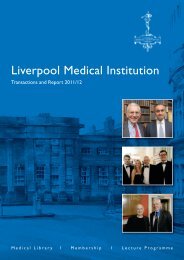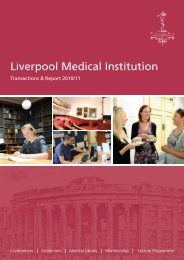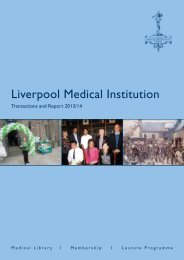LMITransactions&Report2014-15
You also want an ePaper? Increase the reach of your titles
YUMPU automatically turns print PDFs into web optimized ePapers that Google loves.
LMI Transactions and Report 2014 - 20<strong>15</strong><br />
current looped to an indifferent electrode.<br />
FES has a role in the rehabilitation of patients with<br />
Dropped Foot due to upper motor neurone lesions due<br />
to stroke, MS, head injury, cerebral palsy, HSP,<br />
Parkinson’s disease and spinal cord injury (but only<br />
above T12). FES has no role in the rehabilitation in<br />
patients with lower motor neurone damage due to<br />
polio, motor neurone disease, peripheral nerve<br />
damage, Guillain-Barre syndrome or spinal cord injury<br />
below T12.<br />
It was in the 1970s that Nightingale and Glanville set<br />
up FES research in South<strong>amp</strong>ton and, in 1984, the<br />
Spinal Unit at Salisbury began work with FES using a<br />
modified Slendertone machine. The service developed<br />
and an in-house design for FES was introduced<br />
culminating in 37 patients with a variety of<br />
neurological conditions causing a Dropped Foot being<br />
treated between 1988 & 1992. The FES clinical service<br />
started in 1992 coinciding with an article in the<br />
Independent newspaper.<br />
Initially, all the equipment was made in-house for<br />
research work. In 1996, the clinical success of FES was<br />
evident and other centres were asking for the<br />
equipment so the Salisbury unit started manufacturing<br />
to a view to commercial development. In 1998, the<br />
Medical Devices Directive came into force and the<br />
Salisbury unit applied for ISO 9000 accreditation which<br />
was granted in October of that year. Patents were<br />
granted in the UK, US and Canada during the period<br />
2002 – 2004.<br />
(ii) The setting up of a commercial company<br />
It became clear that trying to manufacture and sell<br />
products from within an NHS Department would be<br />
fraught with problems. The sales income distorted the<br />
financial position of the NHS department with issues<br />
such as income not being ring fenced, money not<br />
rolling over from one financial year to the next, lack<br />
of funding for long term investment, not being able<br />
to advertise and difficulties with overseas accounts<br />
being just some of the problems.<br />
However, in 2004, the regulations within the NHS were<br />
changed to allow NHS 3 Star Trusts to set up spin-off<br />
companies to capitalise on R&D work carried out<br />
within these NHS Trusts. A business plan was<br />
submitted in 2005 and Odstock Medical Limited started<br />
trading in April, 2006.<br />
Setting up a spin-off company had its initial problems<br />
(such as separating the company and NHS budgets,<br />
seconding staff between the two entities, appointing<br />
an MD with commercial experience and shareholder<br />
agreements.) The company was set up successfully<br />
with 68% owned by the NHS Trust, 18% by Trustees,<br />
12% by staff and 2% by Bournemouth University. The<br />
company appointed its first directly appointed<br />
employee in December 2006 by taking on its Managing<br />
Director. The company turnover in 2006/07 was £820k.<br />
OML went from strength to strength such that in 20<strong>15</strong>,<br />
3.5 wte NHS staff were seconded to OML, 16.6 staff<br />
were directly employed by OML, there was a separate<br />
accounts system established and the company was<br />
profitable with a projected turnover in 2014/<strong>15</strong> of ~<br />
£1.8m.<br />
(iii) Clinical results for the application of FES<br />
Professor Swain described several clinical cases where<br />
patients experienced significant improvements in<br />
walking following the onset of Dropped Foot. Patients<br />
measured their improvement either in increased<br />
walking speed or increased walking confidence, often<br />
accompanied with a significant decrease in fear of<br />
falling and a consequent increase in stability. Patients<br />
frequently reported a reduced (self-rated) effort in<br />
walking.<br />
As an ex<strong>amp</strong>le, he cited results from a group (n = 144)<br />
of patients with Dropped Foot following Multiple<br />
Sclerosis during the period 2008 - 2013. From that set<br />
of results, 91% of patients were still using FES after 18<br />
weeks, there was a significant increase in walking<br />
speed (p






